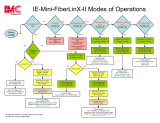4.3 Deploy the SmartFabric .................................................................................................................................... 43
4.3.1 Define VLANs ................................................................................................................................................... 43
4.3.2 LLDP setting for SmartFabric ........................................................................................................................... 44
4.3.3 Create the SmartFabric .................................................................................................................................... 44
4.3.4 Create the Uplink .............................................................................................................................................. 45
4.4 Deploy servers .................................................................................................................................................. 46
4.4.1 Create Server Templates ................................................................................................................................. 46
4.4.2 Add VLANs to the server templates ................................................................................................................. 46
4.4.3 Deploy the Server Templates ........................................................................................................................... 47
4.5 vCenter configuration overview ........................................................................................................................ 48
4.6 SmartFabric connected with MX5108n Ethernet switch and Cisco ACI Leaf switches .................................... 50
5 Validate the configuration ........................................................................................................................................... 52
5.1 MX Validation using OME-M console ............................................................................................................... 52
5.1.1 Show the MCM group topology ........................................................................................................................ 52
5.1.2 Show the SmartFabric status ........................................................................................................................... 53
5.1.3 Show port status ............................................................................................................................................... 55
5.2 Validation using the MX9116n FSE CLI ........................................................................................................... 56
5.2.1 show switch-operating-mode ............................................................................................................................ 56
5.2.2 show discovered-expanders ............................................................................................................................. 56
5.2.3 show unit-provision ........................................................................................................................................... 57
5.2.4 show vlt domain-id ............................................................................................................................................ 57
5.2.5 show vlt domain-id vlt-port-detail ...................................................................................................................... 57
5.2.6 show interface port channel summary .............................................................................................................. 58
5.2.7 show lldp neighbors .......................................................................................................................................... 58
5.2.8 show qos system .............................................................................................................................................. 58
5.2.9 show policy-map ............................................................................................................................................... 59
5.2.10 show class-map ............................................................................................................................................ 59
5.3 SmartFabric Services – Troubleshooting commands ....................................................................................... 60
5.3.1 show smartfabric cluster ................................................................................................................................... 60
5.3.2 show smartfabric cluster member ..................................................................................................................... 60
5.3.3 show smartfabric details ................................................................................................................................... 60
5.3.4 show smartfabric uplinks .................................................................................................................................. 61
5.3.5 show smartfabric nodes .................................................................................................................................... 61
5.3.6 show smartfabric networks ............................................................................................................................... 61
5.4 Cisco ACI validation ......................................................................................................................................... 62
5.4.1 Verify vPC configuration ................................................................................................................................... 62




















